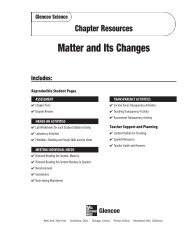Atoms, Elements, and the Periodic Table - Learning Services Home
Atoms, Elements, and the Periodic Table - Learning Services Home
Atoms, Elements, and the Periodic Table - Learning Services Home
Create successful ePaper yourself
Turn your PDF publications into a flip-book with our unique Google optimized e-Paper software.
Name Date ClassMystery MixtureLab PreviewDirections: Answer <strong>the</strong>se questions before you begin <strong>the</strong> Lab.1. Explain why it is important to wear goggles while performing this experiment.H<strong>and</strong>s-On Activities2. What are <strong>the</strong> three tests that you will apply to each compound?You will encounter many compounds that look alike. For example, alaboratory stockroom is filled with white powders. It is important to knowwhat each is. In a kitchen, cornstarch, baking powder, <strong>and</strong> powdered sugarare compounds that look alike. To avoid mistaking one for ano<strong>the</strong>r, you canlearn how to identify <strong>the</strong>m. Different compounds can be identified by usingchemical tests. For example, some compounds react with certain liquids toproduce gases. O<strong>the</strong>r combinations produce distinctive colors. Somecompounds have high melting points. O<strong>the</strong>rs have low melting points.Copyright © Glencoe/McGraw-Hill, a division of <strong>the</strong> McGraw-Hill Companies, Inc.Real-World QuestionHow can <strong>the</strong> compounds in an unknownmixture be identified by experimentation?Goals■ Test for <strong>the</strong> presence of certain compounds.■ Decide which of <strong>the</strong>se compounds are presentin an unknown mixture.Materialstest tubes (4)cornstarchpowdered sugarbaking sodamystery mixturesmall scoops (3)dropper bottles (2)iodine solutionSafety Precautionswhite vinegarhot plate250-mL beakerwater (125 mL)test-tube holdersmall pie panWARNING: Use caution when h<strong>and</strong>ling hotobjects. Substances could stain or burn clothing.Be sure to point <strong>the</strong> test tube away from yourface <strong>and</strong> your classmates while heating.Procedure1. Record your results for each of <strong>the</strong> followingsteps in <strong>the</strong> data table on <strong>the</strong> next page.2. Place a small scoopful of cornstarch on <strong>the</strong>pie pan. Do <strong>the</strong> same for <strong>the</strong> sugar <strong>and</strong>baking soda making separate piles. Add adrop of vinegar to each. Wash <strong>and</strong> dry <strong>the</strong>pan after you record your observations.3. Again, place a small scoopful of cornstarch,sugar, <strong>and</strong> baking soda on <strong>the</strong> pie pan. Adda drop of iodine solution to each one.Wash <strong>and</strong> dry <strong>the</strong> pan after you recordyour observations.4. Place a small scoopful of each compoundin a separate test tube. Hold <strong>the</strong> test tubewith <strong>the</strong> test-tube holder <strong>and</strong> with an ovenmitt. Gently heat <strong>the</strong> test tube in a beakerof boiling water on a hot plate.5. Follow steps 2 through 4 to test yourmystery mixture for each compound.<strong>Atoms</strong>, <strong>Elements</strong>, <strong>and</strong> <strong>the</strong> <strong>Periodic</strong> <strong>Table</strong> 7














